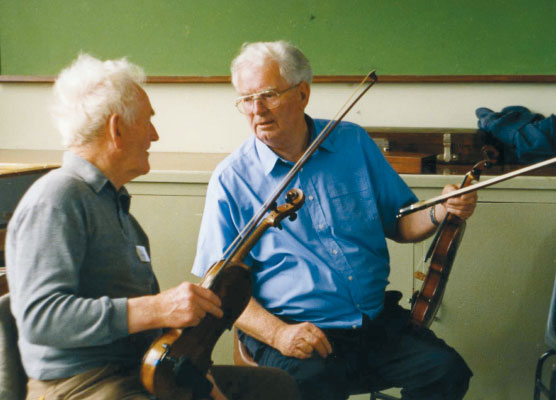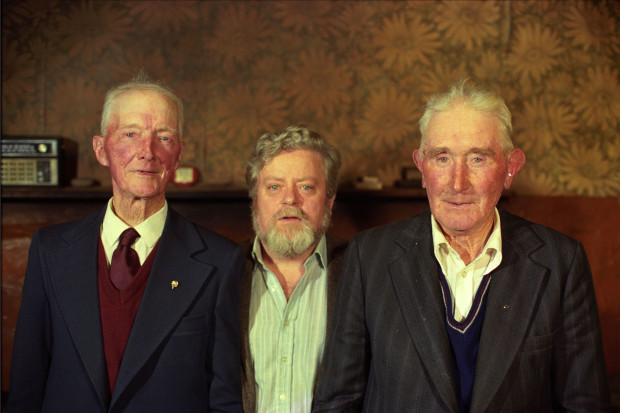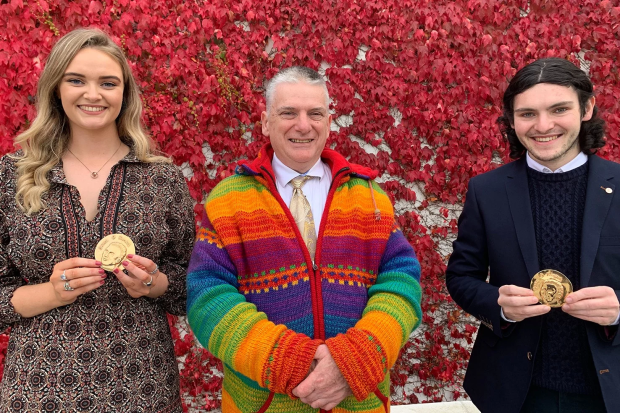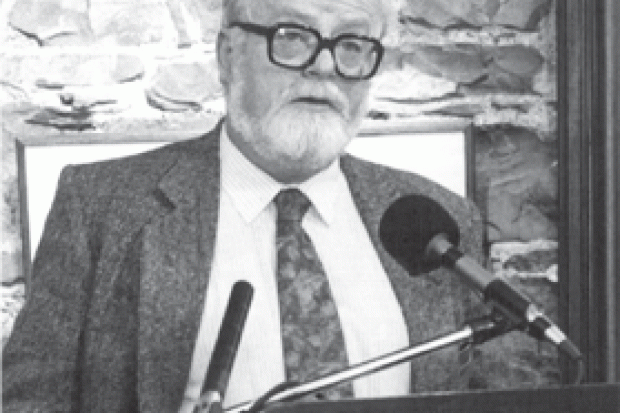
Peadar O’Loughlin (right) with Joe Ryan in Miltown Malbay in 2001. Photo courtesy of the Irish Traditional Music Archive
The Thing Itself
The first paragraph of Pat Mitchell’s notes to Maeve Donnelly and Peadar O’Loughlin’s CD The Thing Itself reads as follows:
There’s nothing more like the thing than the thing itself!’ said Thade Carthy hearing Peadar O’Loughlin play. In language as rich and allusive as that of the great sean-nós songs of Connemara, Thade conferred the ultimate accolade of musicianship on Peadar. In Thade’s day local tunes and styles were highly prized and jealously guarded, and praise given only to those who met the high standards of the knowledgeable listeners. Likewise, departures from good taste would draw an instant reprimand. Thade knew the music of Clare. A musician himself, he grew up and lived surrounded by music all his life. Many of his neighbours played and the quality of the music in his locality may be judged by the continuing regard in which the music of his sister, the fiddle-player Mrs Galvin, is held. So be assured that you will hear only the genuine article – ‘the thing itself’ – on this album.
Whether Thade Carthy’s critique, quip or conundrum can be attributed to the language of sean-nós song is perhaps open to debate; but it does seem wholly within the tradition of the verbal and musical dexterity of the Clare fiddle-masters – Junior Crehan, Bobby Casey, Martin Rochford, to name some. Going further back, the elegance of its word-play seems consonant with that of the great Clare poet Brian Merriman, the author of Cúirt an Mheán Oíche, who according to an entry in John O’Daly’s Clare Ordnance Survey Letters of 1839 had been ‘a wild youth and fond of amusement, a taste which he acquired from being an excellent performer on the violin’. Or, as he ironically refers to himself, ‘Is taibhseach taitneamhach tairbheach tréitheach/ Meidhreach meanmach a ainm ‘s is aerach’ – ‘Who thinks himself droll, and a fiddler of fame/ A man who is Merry by nature and name’, in my inadequate and somewhat free translation. A performer on the ‘violin’ Merriman might well have been, playing the classical music of the time for the local gentry, but given his background he must surely have been primarily a traditional fiddle-player.
Cúirt an Mheán Oíche is undoubtedly the thing itself, a poem of deep linguistic resource, scabrous, tragic and humorous by turns, immensely sophisticated in its verbal music. Unqualified as I am in the linguistic demography of eighteenth-century Ireland, I think that the Irish language in Clare must have been on the wane even then. There are times when there is a kind of desperation in Merriman’s rhetoric and manic word-play. But the writing of Cúirt an Mheán Oíche would not have been possible without an audience sophisticated enough in the language to appreciate its finer points. It is doubtful whether such a poem could be written now, given the current breac-Ghaeltacht or creolised nature of the language. As Pat Mitchell suggests, any art form needs its fanatics, its watchers and listeners who are immersed in its tropes and methods, familiar with its practitioners’ past and present, and who are capable of comparing the thing with the thing itself. Knowing the genuine article, they are the genuine article.
I remember such audiences from small back rooms or public bars in places like Clare, Connemara, Donegal, West Cork, or the musical Bermuda Triangle of Sligo–Leitrim–Roscommon, which, once entered, is difficult to escape from, given the persuasive nature of the hospitality. I see them tapping their feet, giving each other wry nods, winks or nudges, making percussive intakes of breath at an elegantly turned phrase, or drumming their fingers silently along the edge of the bar counter while pretending not to listen. Others simply let an exuberant whoop out of them when the musicians change into the next tune in the set, or maybe a split second before; not without sophistication, for timing in these matters is crucial, and you have to know the disposition of the tunes and what’s likely to come next. Someone will know another version of the tune in question, as played by the fiddler who was the brother of the better-known fiddler, only this fiddler never recorded because he never went to America, and staying where he was he was closer to the thing itself, and was the better musician for it. Or the lady with the big hat and the shopping-bag parked under the table would tell you her mother had a lovely way of lilting it, and would give you a few bars of it in the lull. As much as anything else, this is the thing itself.
But what is the thing itself? Let us say that the accordion players Joe Cooley and Joe Burke, both from Galway, play the thing itself, as would be acknowledged by most musicians and knowledgeable audiences. Each in his own way is a master of his art. Yet there is a huge difference between Cooley’s relatively spare push-and-draw style and Burke’s elaborate series of rolls and grace-notes, which he sometimes attributes to the fiddle-playing of Michael Coleman. Likewise the fiddle-playing of Coleman and that of John Doherty. Or the whistle-playing of Mary Bergin and Micho Russell. Or the sean-nós singing of Nioclás Tóibín and Darach Ó Catháin. I think there is a consensus among the traditional music community as to what constitutes the instantly recognisable real thing; but it is difficult to put into words, beyond saying that it is the real thing, or the thing itself. Perhaps what all these practitioners have in common is integrity, an ability to express their relationship to the music, and to their own experience, through a deep absorption in the tradition. And a good musician must be a good listener.
Listening to Maeve Donnelly and Peadar O’Loughlin’s CD, one does indeed recognise the real thing. I have heard both playing solo, and there are significant differences in their playing styles when they are doing their own thing. Yet they do what good musicians do when they play together: they listen to each other, and accommodate each other. The music is a dialogue born out of knowledge of and respect for each other’s playing. It is a conversation with others who have played the same tunes before them, one strand in a polyphony which extends through time and space, honouring the other occasions on which the music has been played, yet remaining true to this moment of playing, and one’s own way of playing it.
To take one example from the CD, ‘Jack Rowe’s Reel’. As noted by Pat Mitchell, it ‘exemplifies the feel of the music of County Clare. However, Breandán Breathnach notated a version of the tune from Johnny Maguire, a Cavan man living in Belfast and father of the famous fiddler, Seán. The tune appeared in Ceol, Volume 3, No. 1 in 1967 and the name Johnny Maguire gave it was Jack Roe. The similarity of name and melody would suggest that Johnny or Ceol was the original source.’ Or maybe not. Attributions, in the world of traditional music, are notoriously tricky. But the citation tempts me to examine, in the next column in this series, some aspects of the traditional music of Belfast. It will be called ‘The Suffering Ducks’. Read it and find out why.
Published on 1 January 2009
Ciaran Carson (1948–2019) was a poet, prose writer, translator and flute-player. He was the author of Last Night’s Fun – A Book about Irish Traditional Music, The Pocket Guide to Traditional Irish Music, The Star Factory, and the poetry collections The Irish for No, Belfast Confetti and First Language: Poems. He was Professor of Poetry at Queen’s University Belfast. Between 2008 and 2010 Ciaran wrote a series of linked columns for the Journal of Music, beginning with 'The Bag of Spuds' and ending with 'The Raw Bar'.

















